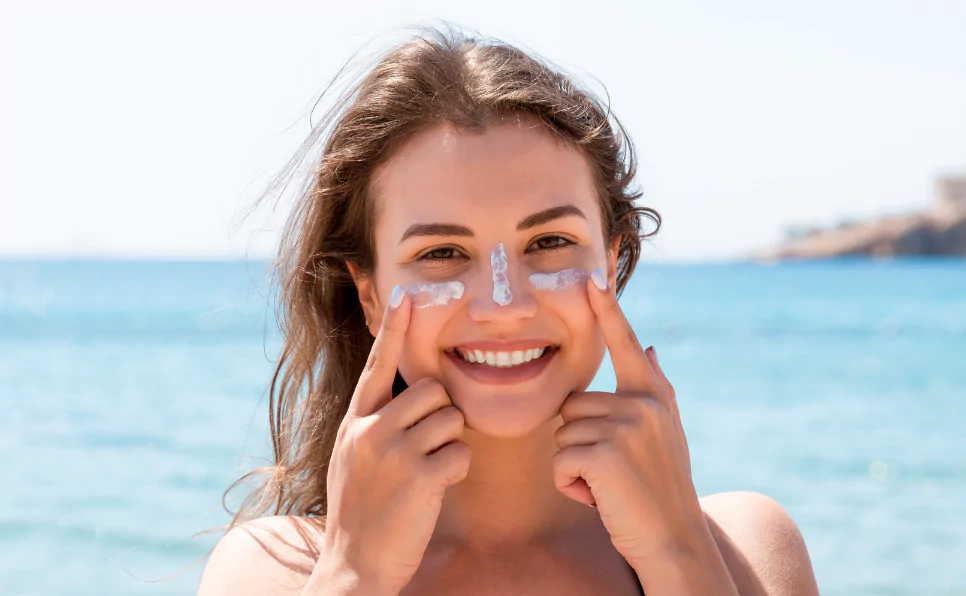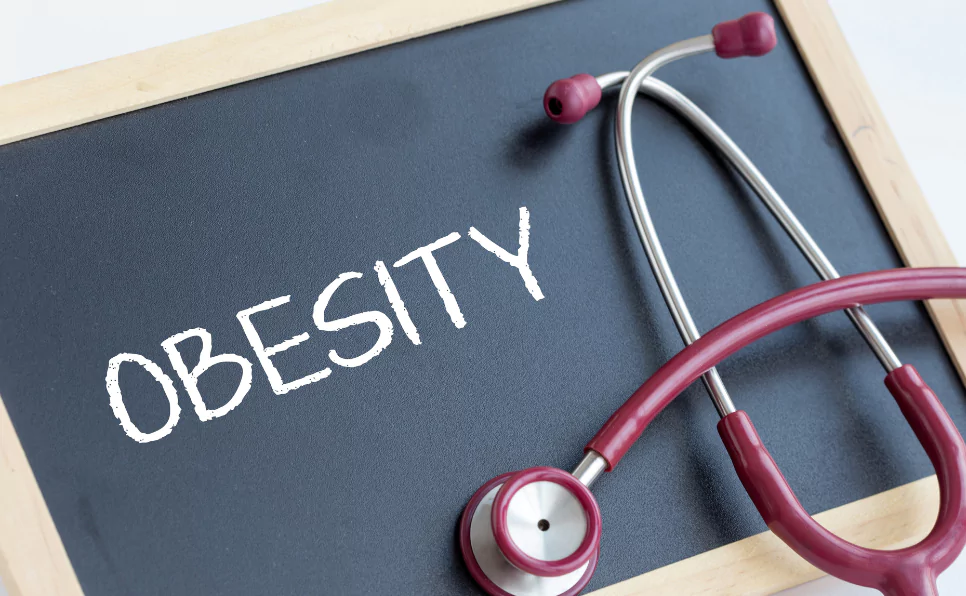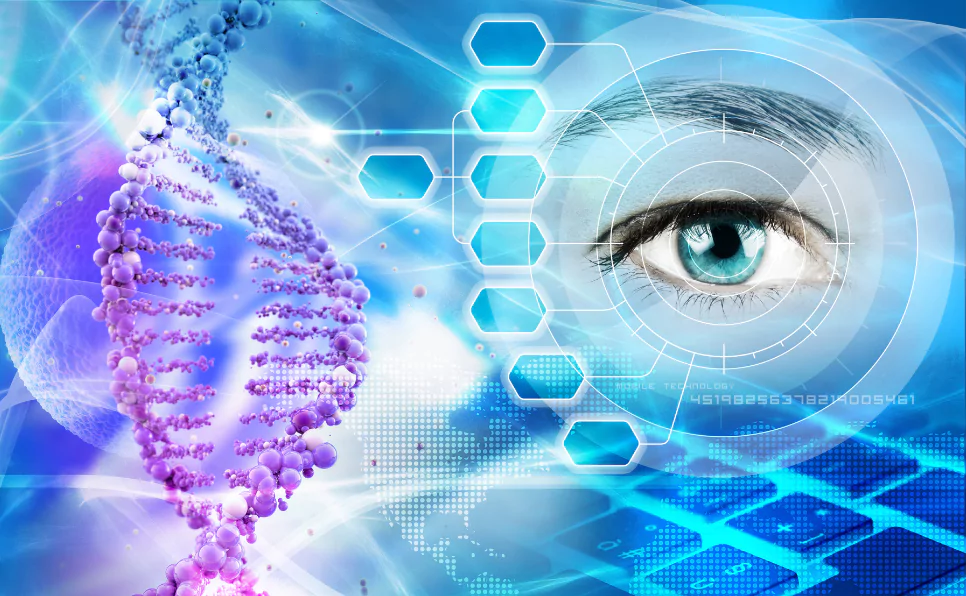Ever noticed how some people sunburn quickly while others tan just fine? Sunburn is common, especially in summer. But what causes it, and why are some people more likely to get it?
When you get too much sun or use tanning beds, the sun’s UV rays can hurt your skin cells’ DNA. This can cause inflammation, redness, and sometimes blisters. This is what we call a sunburn.
Over time, getting lots of sunburns can increase your risk of skin cancer and can make you look older faster.
But everyone’s different. Some people can handle more sun, while others burn easily. This largely comes down to genetics, the traits you get from your parents.
In this article, we’ll explore the genetics of sunburn, how it influences your chances of getting sunburned, and how to protect your skin.
Quick Note:
Susceptibility to sunburn is significantly influenced by genetics. The type and amount of melanin, the skin’s natural protector against UV radiation, vary among individuals due to genetic differences.
The MC1R gene, for instance, determines melanin type and is linked to increased sunburn risk in people with lighter skin.
However, environmental factors like sun exposure duration and intensity also play a role.
Regardless of skin type, it’s essential to take preventive measures against sunburn, such as using sunscreen and wearing protective clothing, to reduce the long-term risks like skin aging and cancer.
For more detailed insights into the genetic factors and protection strategies against sunburn, continue reading this article.
What is Sunburn
Sunburn is like a radiation burn but for your skin, caused by too much UV radiation, usually from the sun.
Common symptoms include red or hot skin, feeling tired, slight dizziness, blistering, peeling skin, swelling, itching, and nausea.
How does it happen?
When UV radiation hits your skin, a pigment in your skin called melanin tries to protect it.
Melanin is made by cells in your skin called melanocytes. It absorbs some of the UV radiation to protect the skin cells.
But if you’re out in the sun too long or it’s too intense, the melanin can’t protect all the skin cells. This causes the DNA damage and inflammation we call sunburn.
What increases the risk?
Getting sunburned depends on several things:
- The intensity and length of time you’re exposed to UV radiation. It’s more intense around noon, in summer, near the equator, and at high altitudes.
- The type and amount of melanin in your skin. Dark brown or black melanin (eumelanin) protects better than red or yellow melanin (pheomelanin). Dark-skinned people have more eumelanin and are less likely to sunburn than lighter-skinned people.
- Your skin’s sensitivity to UV radiation. Some people’s skin is more sensitive due to genetics or conditions that affect their skin’s ability to repair DNA damage. For example, people with a rare genetic disorder called xeroderma pigmentosum (XP) are very prone to sunburn and skin cancer.
Short and long term effects of sunburn
Sunburn can cause problems right away and down the road.
Immediately, it can cause:
- Pain and discomfort that can mess with your day-to-day life and sleep.
- Dehydration and electrolyte imbalance due to fluid loss from damaged skin.
- Infections and scarring if blisters break or get contaminated.
- Eye damage from UV radiation exposure without eye protection, causing inflammation or cataracts.
Long-term effects can include:
- Skin aging from chronic exposure to UV radiation, causing wrinkles, sagging, dryness, and age spots.
- Skin cancer from too much UV radiation exposure, causing abnormal growths of skin cells, some of which can be cancerous. The most common types are basal cell carcinoma, squamous cell carcinoma, and melanoma.
- Weaker immune system from repeated UV radiation exposure, reducing the skin’s ability to fight infections and diseases.
Our Skin and Sunlight
Our skin is the body’s biggest organ. It does lots of jobs. It shields us from outside things, controls body heat, and feels the world around us through nerves.
The skin has three layers: the top layer (epidermis), the middle layer (dermis), and the deep layer (hypodermis).
The epidermis is the top skin layer. It’s like a waterproof coat and gives skin its color.
The color comes from a pigment called melanin, made by special cells named melanocytes.
Melanin shields the skin from sun damage by soaking up UV rays. This is like a natural sunscreen gene.
The dermis is the middle skin layer. It supports the epidermis, making it strong. It’s got blood vessels, lymphatic vessels, hair roots, sweat glands, oil glands, and nerves. It also creates collagen and elastin, giving skin its bounce and strength.
The hypodermis is the deep skin layer. It’s mostly made of fat. It feeds the other two layers and acts like a cushion, keeping the body warm.
Sunlight is key for our health. It helps our body make vitamin D. This is crucial for healthy bones, a strong immune system, and good moods.
But too much sun can harm the skin, causing sunburns, aging, and skin cancer. In essence, this is the genetics of sunburn in action, as sunburn is caused by DNA damage.
How the sun affects the skin depends on skin type. Skin type is decided by how much melanin it has and how it reacts to the sun.
There’s a scale called the Fitzpatrick scale that classifies skin types into six groups:
- Type I: Pale white skin, blue/green eyes, blond/red hair. Always burns, doesn’t tan.
- Type II: White or fair skin, blue eyes. Burns easily, tans poorly.
- Type III: Darker white skin. Tans after burning.
- Type IV: Light brown or olive skin. Barely burns, tans well.
- Type V: Brown skin. Hardly ever burns, tans darkly.
- Type VI: Dark brown or black skin. Never burns, always tans darkly.
People with lighter skin (Type I and II) have less melanin. They’re more sensitive to UV rays and need more sun protection. They’re more likely to get sunburns and skin cancer. This is a clear example of how sunburns are genetic.
On the other hand, people with darker skin (Type V and VI) have more melanin. They’re less sensitive to UV rays and need less sun protection. They’re less likely to get sunburns and skin cancer.
But they can still get sun damage, so they should still protect their skin.
Genetics of Sunburn
But why do some folks burn faster than others? The answer is in our genes – the bits of our DNA that help decide how our bodies work.
Our genes can affect how our skin reacts to sunlight.
As we discuss above our skin makes the protein melanin. But not everyone makes the same amount or type of melanin.
There’s a gene called melanocortin 1 receptor (MC1R).
This gene helps decide how much and what kind of melanin our skin makes. There are two main types of melanin.
The first one, eumelanin, is dark and helps protect our skin from UV radiation. The second one, pheomelanin, is lighter and doesn’t protect the skin as much.
The MC1R gene can change how much of each type of melanin we make.
Some changes in this gene can lead to red hair, light skin, freckles, and getting sunburns more easily.
These changes also raise the risk of getting skin cancer, especially the most deadly type called melanoma.
For example, people with Celtic or Northern European roots often have changes in their MC1R gene.
This makes them more likely to get sunburned. Others who burn easily are people with albinism, who don’t have much melanin, and people with a rare genetic disorder called xeroderma pigmentosum.
This condition makes it harder for the skin to repair DNA damage caused by UV radiation.
Other Important Factors in Sunburn
But genes aren’t the only thing that matters. Other factors can also affect whether you get a sunburn.
These include:
- How long you’re in the sun
- The time of day and time of year
- Where you are in the world
- How UV radiation bounces off surfaces like water, snow, sand, or concrete
- Whether you’re using sunscreen or other sun protection
- If you’re taking medications that can make your skin more sensitive to the sun
- If you have other skin conditions or diseases
So, it’s important to know your risks, both from your genes and from other factors, and to protect your skin from the sun.
Steps to Avoid Sunburn
It’s a must to keep your skin safe from sunburn, no matter if you’re more prone to it because of your genetics or not.
Some think that having dark skin or getting tan easily means they won’t burn. That’s not true.
Sunburn can happen to anyone. Even getting a slight tan means your skin has been harmed.
Here’s how you can stop sunburn from happening.
First, use sunscreen. Make sure it fights against both UVA and UVB rays and has an SPF of 15 or more.
Apply it evenly on all skin areas that will be exposed to the sun.
Do this at least 15 minutes before going out and every two hours after that. If you’re going to swim or if you sweat a lot, apply more often.
Second, cover up. Wear clothes that cover your skin as much as possible. Pick long-sleeved tops, trousers, hats, and sunglasses.
Avoid clothes that are tight or dark as they can make you feel hotter. Go for light, breathable clothes that have a UPF (ultraviolet protection factor) rating of 30 or more.
Third, stay out of the sun when it’s the strongest. This is usually between 10 a.m. and 4 p.m.
Find shade when you can, like under trees or awnings. Also, look at the UV index for your area.
The UV index shows how strong the UV radiation is, on a scale from 1 to 11+. If the UV index is high, the chance of getting sunburn is higher.
You can find the UV index online or on your phone.
Food That can Help Against Sunburns
On top of these, watch what you eat and drink for sunburn prevention. Foods rich in vitamins, minerals, and antioxidants help your skin heal faster and lower your risk of cancer.
Foods good for sunburn include:
- Carrots, pomegranates, and tomatoes. These have lycopene and other substances that keep your skin safe from UV harm.
- Green tea, because it fights inflammation and cancer.
- Oatmeal, as it has a rare antioxidant that lowers redness and swelling.
- Dark chocolate, as it helps your skin get more blood and stay hydrated.
- Cucumbers, watermelon, and buttermilk. These cool and soothe the skin.
It’s also important to stay hydrated to avoid dehydration. Dehydration can make sunburn symptoms worse and harm your health.
Try to drink at least eight glasses of water daily. If you’re sweating or exercising in the heat, drink more.
Drinks with electrolytes can also help replace minerals lost through sweating.
Stay away from alcohol and caffeine, as they can dehydrate you more and cause inflammation.
If you follow these steps, you can have fun in the summer without damaging your skin or health.
Always be smart about the sun and take care of your skin before, while, and after being in the sun.
This could be your best defense against the genetics of sunburn and the DNA damage that comes with it.
DNA Testing To Check if You’re Prone to Sunburn?
You might be wondering, “Are sunburns genetic?” Yes, they can be. Your DNA can affect how fast you get a sunburn.
Some people’s genes make them more likely to get sunburned. This is because their genes affect how melanin is made and spread.
Melanin is what gives your skin its color and defends it against the sun’s harmful rays.
Now, there’s something called “genetic testing for sunburn risk”. This test looks at your DNA to see if you have genes that make you get sunburned more easily.
By checking a bit of your spit or blood, this test can tell you how likely you are to get sunburned compared to other people.
It helps you understand your personal chance of getting sun damage and skin cancer. It can help you know how to keep your skin safe.
But this test isn’t 100% accurate in predicting if you’ll get sunburned. Lots of things affect how your skin responds to the sun.
Things like how old you are, your skin type, the medications you’re taking, and the weather.
Plus, these tests aren’t checked by the FDA. So, their accuracy and reliability might change depending on the company that’s giving them.
So, it’s good to be careful when looking at the test results. And you should talk to a doctor before you change anything about how you protect your skin from the sun.
Also, be careful about who you share your genetic information with. Employers, insurance companies, or family members could misuse it.
Final Words
In this post, we talked about the genetics of sunburn, and how a test can tell you more about how your skin reacts to the sun.
We also talked about the good and bad sides of these tests, and how to use them wisely.
We hope that you now know more about the link between your DNA and sunburn. And how this could affect your health.
But remember, no matter what your genes are like, you should always keep your skin safe from the sun.
Here’s how:
- Stay out of the sun during the hottest part of the day (10 a.m. to 4 p.m.).
- Use sunscreen with high SPF (at least 30) and protection against all types of harmful rays, even on days when it’s cloudy.
- Put on more sunscreen every two hours. Do it more often if you’re swimming or sweating.
- Wear clothes that protect you from the sun. Things like hats, sunglasses, long-sleeved shirts, and pants.
- Try to stay in the shade as much as you can.
- Don’t use tanning beds or other fake sources of sunlight.
By doing these things, you can lower your chances of getting sunburned. And you can avoid the bad things that come with it, like aging faster, damaging your skin, and getting skin cancer.
But you can still enjoy the good things the sun gives us, like vitamin D, a better mood, and a stronger immune system.
Thanks for reading this post. We hope it’s been useful. Please share it with your friends and family who might want to learn more about the sunscreen gene and sunburns.
FAQs
What’s a skin cancer gene?
Skin cancer happens when skin cells grow uncontrollably. Some people have a higher risk of skin cancer because of their DNA.
Their genes make them more likely to get skin damage from the sun. This is part of the “genetics of sunburn”.
Different genes can lead to skin cancer. Some genes, like CDKN2A, BAP1, and TP53, normally stop cells from growing too fast. If these genes change, they can’t do their job and cells grow out of control.
There are other genes, like BRAF, NRAS, and MITF, that help cells grow. If these genes change, they can make cells grow too fast.
If you’ve got these gene changes from your parents, you’re more likely to get skin cancer at a younger age. But remember, most skin cancers are caused by things like sun exposure, not just genes.
If your family has a history of skin cancer or you see strange changes on your skin, go see a dermatologist. They can check you out and suggest what to do next. You might need to get checked for these gene changes.
Do humans have natural sunscreen?
Humans don’t have a natural sunscreen to put on their skin. But, we do have ways to protect our skin from sun damage.
We have melanin, a pigment that gives color to our skin, hair, and eyes. Melanin helps shield our skin from the sun’s harmful rays.
People with darker skin have more melanin and are naturally more protected. But, everyone still needs sunscreen for extra protection.
Our skin also becomes inflamed when it gets too much sun. This is what causes sunburns. This is a sign that our skin has been hurt by the sun. But constant inflammation can lead to skin problems. So, it’s better to avoid too much sun and use sunscreen.
Is sun sensitivity genetic?
Sun sensitivity is when your skin reacts badly to sunlight. This can lead to things like redness, itching, and burning. It can also make you more likely to get sunburns and skin cancer.
Some people are born with genes that make their skin more sensitive to the sun. Conditions like Xeroderma pigmentosum (XP), Erythropoietic protoporphyria (EPP), and Polymorphous light eruption (PMLE) can make people more sun sensitive.
This is how “are sunburns genetic” is true in some cases.
There are other causes of sun sensitivity that aren’t genetic, like certain medications, medical conditions, or even some foods or cosmetics.
A dermatologist can diagnose sun sensitivity and recommend treatment. Usually, this includes avoiding the sun, using sunscreen, and treating any other conditions.
What’s the biology of sunscreen?
Sunscreen protects our skin from the sun’s harmful rays. It can block or absorb these rays before they hurt our skin.
There are two types of sunscreen: physical and chemical. Physical sunscreens sit on top of your skin and bounce off the sun’s rays. Chemical sunscreens soak into your skin and absorb the sun’s rays.
Each type has pros and cons. Physical sunscreens are stable and gentle but can leave a white cast on darker skin. Chemical sunscreens are clear and easy to spread but can cause allergies and damage the environment.
Sunscreen’s power is shown by its SPF. For instance, SPF 15 lets only 1/15th of the sun’s rays hit your skin. It’s recommended to use sunscreen with at least SPF 30.
You should put on sunscreen 15 minutes before going out and reapply every two hours or after swimming or sweating. Remember to use hats, sunglasses, and clothing to protect yourself too.
Can sensitive skin be genetic?
Sensitive skin can react badly to things like heat, cold, wind, and more. Yes, sensitive skin can be genetic.
Some people are born with genes that make their skin more sensitive. But there can also be other causes, like certain skin products or environmental factors.
References:
- Xeroderma pigmentosum – Wikipedia
- Sunburn – Wikipedia
- Genes controlling whether skin tans or burns discovered by scientists
- 11 Sunburn Statistics and Facts [2023 Update] – The Sun Is Trying To
- Sunburn – Symptoms and causes – Mayo Clinic
- How to Prevent a Sunburn: 10 Steps (with Pictures) – wikiHow
- Sunburn: Treatments, home remedies, and prevention – Medical News Today
- Sunburn and sun protection – treatments and prevention including
- Overview of Sunlight and Skin Damage – Skin Disorders – MSD Manual
- The Fitzpatrick Classification Scale for Skin Types – Verywell Health
- Is it possible to increase melanin in your skin? – Medical News Today
- Do You Need Sun Protection for Skin of Color? – WebMD
- How To Reduce Excess Melanin Caused By Sun Exposure? – Cureskin
- How Melanocytes Defend Your Skin Against UV Rays – Verywell Health
- Overview of Effects of Sunlight – Dermatologic Disorders – MSD Manual
- Xeroderma pigmentosum: Rare disease causes an extreme sensitivity to
- What happens when you get a sunburn – MD Anderson Cancer Center
- Melanocortin 1 receptor gene | DermNet
- Melanocortin 1 receptor (MC1R) gene variants may increase the risk
- Redhead and Increased Health Risks
- Sunburn – The Skin Cancer Foundation

Dr. Sumeet is a seasoned geneticist turned wellness educator and successful financial blogger. GenesWellness.com, leverages his rich academic background and passion for sharing knowledge online to demystify the role of genetics in wellness. His work is globally published and he is quoted on top health platforms like Medical News Today, Healthline, MDLinx, Verywell Mind, NCOA, and more. Using his unique mix of genetics expertise and digital fluency, Dr. Sumeet inspires readers toward healthier, more informed lifestyles.





